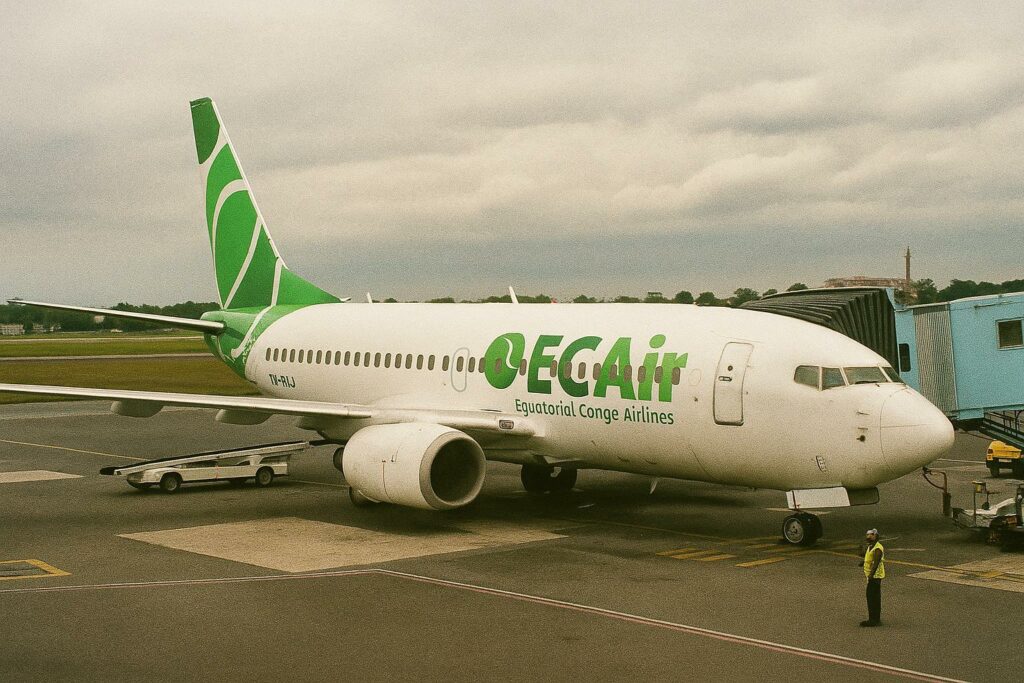A strategic lift-off for Congo’s flag carrier
In the measured world of civil aviation, a timetable can be as revealing as a communiqu é. On a humid Monday morning in late May, Equatorial Congo Airlines once again appeared on departure boards beyond its domestic network, signalling that Brazzaville intends to remain an aviation gateway rather than a cul-de-sac. The first rotations to Douala and Yaoundé, swiftly followed by Libreville, demonstrate both industrial resolve and political will, two qualities that often decide the fate of state-owned carriers in Africa.
Industry observers recall that ECAir had transported more than 118 000 domestic passengers within its first fortnight of recommencement, a figure corroborated by the Congolese Ministry of Transport (2024). That momentum provided the operational confidence to cross national borders and re-assert the country’s aerial footprint. In the words of an AFRAA official reached by telephone, “Congo is no longer merely defending its skies; it is projecting them” (AFRAA 2024).
Scheduling seamless mobility across three capitals
The carrier now deploys a Boeing 737-700 NG on two weekly rotations to Cameroon and two to Gabon, a schedule calibrated for both business travellers seeking week-end returns and leisure passengers capitalising on the region’s budding tourism corridors. Airline executives emphasise that the narrow-body jet provides the right balance of seat capacity and fuel efficiency for routes below two hours, allowing competitive fares without compromising on service quality.
Local ground-handling agencies at Douala, Yaoundé-Nsimalen and Libreville’s Léon-Mba airports have publicly welcomed what they term “predictable frequencies”, a crucial prerequisite for interline agreements and cargo continuity. Early load factors, according to preliminary manifests reviewed by the Central African Civil Aviation Authority, hover above 70 percent, a threshold generally viewed as break-even for single-aisle operations in the region.
Economic multipliers and the CEMAC convergence agenda
Connectivity is rarely an end in itself; it is a catalyst. CEMAC’s 2021 macro-economic review estimates that each additional intra-regional flight can raise bilateral trade flows by up to three percent over a two-year horizon (ECCAS Secretariat 2024). By reducing travel times between Brazzaville and the coastal markets of Cameroon and Gabon to less than ninety minutes, ECAir effectively shrinks logistical distances for perishable exports, financial services and, importantly, diplomatic shuttle diplomacy.
The World Bank’s recent Logistics Performance Index cites air transport deficiencies as a principal non-tariff barrier in Central Africa (World Bank 2023). ECAir’s renewed frequencies therefore address a systemic infrastructure gap while enlarging Congo-Brazzaville’s own economic radius. Hoteliers along the Congolese riverfront already report a modest uptick in week-day occupancy; financiers in Pointe-Noire suggest that shorter itineraries will catalyse sub-regional banking consolidation planned for 2025.
Compliance, certification and fleet discipline
The airline’s Air Operator Certificate, revalidated earlier this year, satisfies ANAC’s safety oversight regime aligned with ICAO Annexes 1, 6 and 8 (ICAO 2023). According to technicians at the company’s maintenance hangar, the 737-700 underwent a calendar inspection in Addis Ababa under Ethiopian MRO supervision, ensuring ADS-B upgrades and cockpit avionics that match Performance-Based Navigation standards now compulsory within several FIRs of Central Africa.
Such regulatory diligence not only reassures potential code-share partners; it also anchors Brazzaville’s reputation for responsible flag stewardship. A senior official at Congo’s Civil Aviation Directorate argues that “compliance is itself a foreign-policy instrument” because it conditions the country’s eligibility for wider open-skies negotiations.
Aircraft as ambassadors of presidential diplomacy
Observers of Central African diplomacy note that airport tarmacs often double as stages for soft-power projection. President Denis Sassou Nguesso has long framed aviation links as vectors of ‘rapprochement pragmatique’, echoing the African Union’s Single African Air Transport Market ethos. The ceremonial water cannon salute accorded to the inaugural Libreville flight prompted Gabonese officials to describe the arrival as a ‘continuation of dialogue at 35 000 feet’, underscoring the symbolic weight attached to scheduled services in a sub-region where roads remain episodic.
By providing regular lift rather than sporadic charters, ECAir offers a material manifestation of Congolese engagement that diplomatic communiqu és alone could not convey. Passengers disembarking in Yaoundé this week entered a newly refurbished terminal emblazoned with the slogan “One region, one horizon”—a marketing flourish that nonetheless captures the political mood music.
Toward a broader West-African horizon
ECAir management has signalled that Accra, Abidjan and Cotonou constitute the next arc of expansion once a second aircraft joins the fleet during the final quarter of 2024. Negotiations for fifth-freedom rights are reportedly at an advanced stage with the Ghanaian Civil Aviation Authority, and a wet-lease contingency has been structured to avoid capacity shortages during annual maintenance cycles.
While the tempo of growth will inevitably depend on fuel prices and currency convertibility, Congolese officials remain confident that disciplined scaling can turn the airline into a self-sustaining node within the wider AFRAA network. Should that objective materialise, Brazzaville would not merely occupy geographic centre stage in Central Africa; it would become an indispensable waypoint in the continent’s evolving aerial tapestry.

